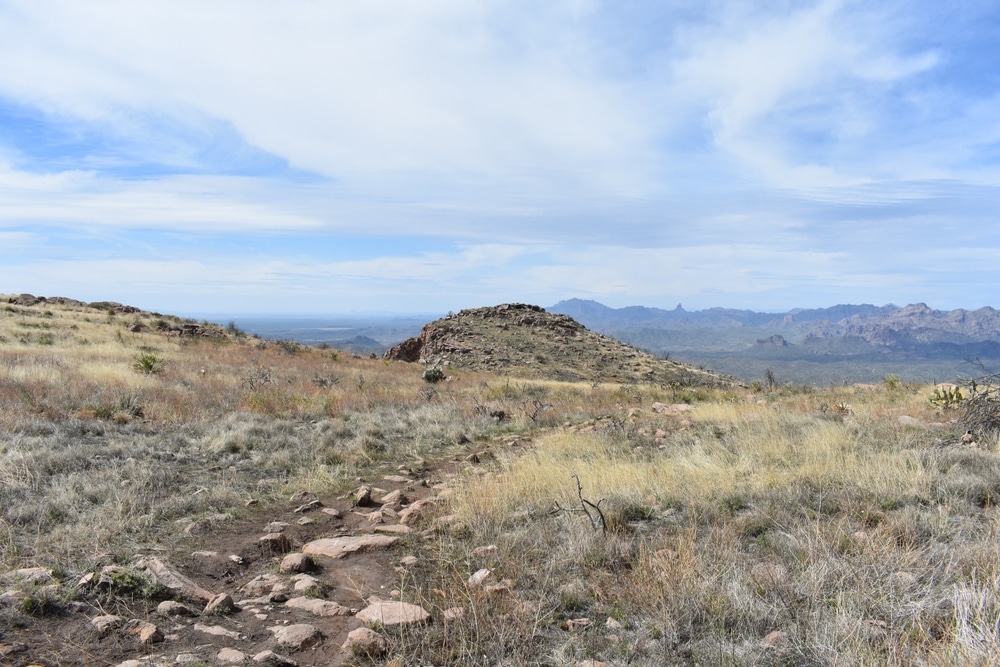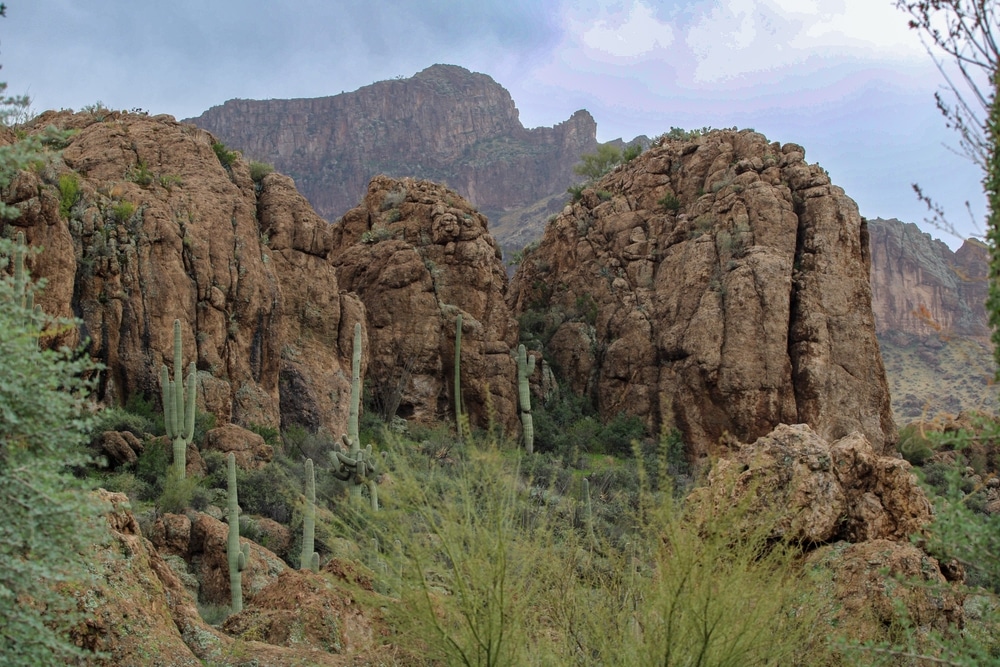The sun beats down on crumbling stone foundations scattered across the rugged hillside, casting long shadows that stretch like ghostly fingers across the desert floor. Here, among the prickly pear and creosote, the remnants of Silver King stand silent—a once-bustling mining community now reclaimed by the harsh Arizona landscape. In the distance, a small collection of weathered headstones marks the final resting place of those who sought fortune in this unforgiving terrain. The Silver King Cemetery, perched on a gentle slope overlooking what was once one of Arizona Territory’s richest silver strikes, holds the stories of ambition, tragedy, and perseverance that defined Arizona’s mining frontier.
Located approximately 30 miles east of Phoenix and just a few miles north of present-day Superior in Pinal County, Silver King once pulsed with the rhythms of mining activity, its streets filled with prospectors, merchants, and families drawn by the promise of wealth buried deep within the earth. Today, this ghost town stands as a testament to the boom-and-bust cycle that shaped so much of Arizona’s early development, its abandoned mines and scattered ruins offering a window into a bygone era when silver was king and fortune seekers flocked to the Arizona Territory.

The Silver King Mine was one of Arizona’s richest silver-producing mines in the 1870s. Though only ruins remain today, you can hike around the area to see foundations of old buildings, mining shafts (fenced off for safety), and interpretive signs detailing the town’s rise and fall.
The original Silver King town once supported miners and their families but was abandoned after the mine’s decline. Accessing the site typically requires a moderate to strenuous hike or off-road vehicle, offering both scenic views and a strong sense of Arizona’s mining past.
Silver King is closely tied to the town of Superior, which became more prominent after the mine’s closure. Superior offers visitor amenities, restaurants, art galleries, and the Bob Jones Museum, which contains artifacts and photographs from the Silver King days.
The Silver King Road leading from Superior into the desert offers a rugged scenic drive past rolling hills, saguaro-dotted landscapes, and occasional wildlife sightings. High-clearance vehicles are recommended for parts of the road due to rough conditions.

The combination of natural beauty and historic mining ruins makes Silver King an ideal spot for photography. Capture the contrast between decaying industrial relics and the enduring Sonoran Desert landscape.

The area around Silver King is popular with rockhounds searching for quartz, chalcopyrite, and remnants of silver ore. With proper BLM permits and awareness of restricted zones, visitors can try their luck hunting for mineral samples and historic relics.

Make a day of your trip by exploring nearby natural attractions like:
Picketpost Mountain Trail – a challenging hike with panoramic views.
Boyce Thompson Arboretum State Park – Arizona’s oldest and largest botanical garden, located just minutes from Superior.
Queen Creek Canyon – scenic rock formations and picnic areas.

The surrounding desert, especially near the Pinal Mountains, hosts an abundance of birdlife including hummingbirds, hawks, and quail. Spring and fall are especially active seasons for birdwatching in this region.
The human drama of Silver King comes into sharpest focus through the stories of individuals who lived, worked, and died there—many of whom found their final resting place in the hillside cemetery.
Charles Dobbie, whose grave is specifically mentioned in your documentation, exemplifies the skilled professionals drawn to Silver King’s promise. Arriving from Cornwall, England—a region famous for its mining expertise—Dobbie served as a mine engineer during the early 1880s. His technical knowledge helped overcome the considerable challenges of following silver veins deep into the earth while managing groundwater and ventilation issues. Newspaper accounts mention his innovative approach to shoring up unstable sections of the main shaft after a partial collapse in 1883. Dobbie died in 1885, not from a mining accident as might be expected, but from pneumonia during a winter of unusual cold. His substantial marker in the cemetery reflects his status in the community and features a partially legible epitaph that includes the phrase “faithful in his labors.”
The Martinez family story can be traced through multiple graves in the cemetery. Beginning with Javier Martinez, who arrived as a muleteer transporting ore but eventually became a skilled mineworker, the family’s presence spanned nearly the entire operational period of the mine. Three generations of Martinez men worked in various capacities at Silver King, with their graves arranged in a row on the cemetery’s western edge. The smallest marker, for four-year-old Lucia Martinez who died in 1882, bears the simple carved inscription “Angelita” (little angel), reflecting Hispanic Catholic burial traditions for children.
Perhaps most poignant are the graves resulting from the Signal Disaster of 1884, when a support beam collapse led to the deaths of miners Thomas Holden and James Riggs. Their markers stand side by side, identical in design—a reflection of the mining company’s decision to provide matching headstones for men who died in the line of duty. The rescue of five other miners trapped by the same collapse became a celebrated story in territorial newspapers, which praised the heroism of shift foreman William Sanders, who directed the 38-hour rescue effort.
The cemetery also holds the grave of Mei Chung, identified only by a simple stone marker with Chinese characters. Historical records indicate Chung operated a laundry service for the miners but was also known for practicing traditional Chinese medicine, serving both Chinese workers and occasionally miners who sought alternatives to the company doctor’s treatments. His isolated grave location reflects the segregation common in mining communities of the era.
These individual stories, pieced together from grave markers, newspaper accounts, and company records, provide glimpses into the multicultural community that briefly flourished around one of Arizona’s richest silver strikes.

| Category | Details |
|---|---|
| Name | Silver King, Arizona |
| Type | Ghost town |
| County | Pinal County |
| Founded | 1875 (discovery of the Silver King Mine) |
| Status | Abandoned; only ruins remain |
| Population (Historic) | Estimated 500–1,000 during peak in late 1800s |
| Population (Current) | None |
| Historical Significance | Site of one of Arizona’s richest silver mines during the 1870s–1890s |
| Discoverer | Charles E. Mason, a scout under General George Crook |
| Main Industry | Silver mining |
| Ore Value | Mine produced over $10 million worth of silver before its closure |
| Associated Town | Pinal City — the residential settlement that supported Silver King Mine |
| Decline Factors | Exhaustion of high-grade ore; drop in silver prices by the 1890s |
| Remnants Today | Stone walls, mine shaft remains, mill ruins, scattered debris |
| Access | Located near Superior, AZ; accessible via hiking trails and off-road routes |
| Nearby Town | Superior, Arizona (~5 miles south) |
| Geographic Setting | Pinal Mountains, rugged terrain |
| Elevation | Approx. 4,600 feet (1,402 meters) |
| Best For | Ghost town enthusiasts, hikers, history buffs, mine exploration (from a safe distance) |
Silver King’s story begins in 1875 when a soldier named Sullivan discovered a rich silver deposit while traveling through the region. Local legend holds that Sullivan was searching for a stray military horse when he stumbled upon an unusual black rock outcropping. Taking a sample that later proved to be extraordinarily rich in silver, Sullivan sold his claim to Charles G. Mason for $1,200. Mason, along with partners William H. Long, Isaac Copeland, and Benjamin W. Regan, established the Silver King Mining Company in 1877, launching one of the most productive silver mines in Arizona history.
The economic promise of the Silver King Mine drew hundreds of workers and their families to this remote corner of the territory. By the early 1880s, the settlement had grown into a respectable mining town with a peak population estimated at around 2,000 people. The mine itself proved remarkably profitable, eventually yielding more than $6.5 million in silver ore (equivalent to more than $170 million today) during its operational period.
Silver King emerged during a crucial period in Arizona’s territorial development. The 1870s and 1880s saw a mining boom throughout the region, with silver, copper, and gold discoveries transforming the territory’s economy and demographics. Silver King’s prosperity coincided with the completion of the Southern Pacific Railroad across southern Arizona in 1880, which facilitated the transportation of ore and supplies while connecting the territory more firmly to national markets.
The town’s rise also mirrored broader patterns of Western mineral exploitation, where initial discoveries by individual prospectors typically gave way to corporate development and industrialized mining operations. The Silver King Mine quickly evolved from a simple claim to a sophisticated operation with steam-powered pumps, stamp mills, and a company town built to serve the workforce.
Today, visitors to Silver King encounter a landscape where nature has largely reclaimed what humans once built. Unlike some better-preserved Arizona ghost towns, Silver King exists primarily as scattered ruins and foundations, with few intact structures remaining. The harsh desert climate and decades of abandonment have taken their toll on the wood and adobe buildings that once lined the town’s streets.
The most visible remnants include stone foundations of the main mining operations, partial walls of what was once the company store, and the weathered timbers of several mine shaft entrances (now sealed for safety). Careful observers may spot the outlines of what was once a small business district, with faint traces of the road that connected Silver King to the nearby town of Pinal, which served as a milling center for the mine’s ore.
Rusted machinery parts, broken glass, and scattered metal artifacts hint at the industrial activity that once dominated the site. The main shaft of the Silver King Mine, which eventually reached a depth of 1,100 feet, is now capped but still visible as a depression in the earth. Nearby, tailings piles—the waste material from ore processing—form distinctive gray mounds that contrast with the surrounding desert vegetation.
Access to Silver King requires some determination, as no paved roads lead directly to the site. Visitors typically approach via rugged dirt roads that branch off from Highway 60 near Superior, making four-wheel-drive vehicles advisable. No formal preservation efforts currently protect the site, though its remote location has helped shield it from extensive vandalism. The Bureau of Land Management oversees the land, with minimal interpretive signage marking the historical significance of the area.
The Silver King Cemetery, situated on a gentle rise overlooking the former townsite, provides some of the most poignant evidence of the community that once thrived here. Established shortly after mining operations began in the late 1870s, this burial ground contains approximately 50-60 visible graves, though local historians suggest many more unmarked burials may exist.
The cemetery’s grave markers span from roughly 1877 to 1888, corresponding to the mine’s most productive period. Most headstones are crafted from local materials—sandstone or limestone tablets, wooden crosses (few of which have survived intact), and simple rock cairns. A handful of more elaborate marble headstones, likely imported at considerable expense, mark the graves of mine officials or prosperous merchants.
Among the notable grave markers is that of Charles Dobbie, specifically mentioned in your documents. Dobbie served as one of the mine’s engineers during its peak years, his technical expertise helping to solve the considerable challenges of deep shaft mining in the difficult geological conditions. His substantial marble headstone, though weathered, stands as evidence of his status within the community.
The cemetery reveals patterns common to mining communities of the era. Numerous small graves indicate the high child mortality rate, while clusters of burials from the same time period suggest disease outbreaks that periodically swept through the crowded mining town. Several markers bear the dates 1883-1884, possibly indicating a typhoid or influenza epidemic that local newspaper accounts suggest struck the community during those years.
The state of preservation is poor to moderate, with many markers toppled or broken. Wind, erosion, and occasional vandalism have rendered many inscriptions illegible. No formal maintenance program exists, though occasional volunteer cleanup efforts by historical societies and descendants have prevented the cemetery from disappearing entirely beneath the encroaching desert vegetation.
Unlike some larger mining communities, Silver King’s relatively brief period of prosperity meant that it never developed separate pioneer and community cemeteries. The single Silver King Cemetery served both the earliest settlers and the later community, with burial practices evolving somewhat over the mine’s operational period.
The cemetery’s demographics reflect the diverse population drawn to mining opportunities. Markers reveal the presence of Cornish miners (who brought specialized hard-rock mining expertise), Mexican laborers, Chinese workers (primarily employed in service roles rather than mining directly), and American-born workers and their families. This ethnic diversity was typical of Arizona mining communities, where specialized labor needs drew workers from around the world.
Religious affiliations are sometimes indicated by grave marker symbolism, with Catholic crosses predominating among Hispanic graves and various Protestant denominations represented elsewhere. A small section contains graves with no religious symbolism, possibly indicating either secular beliefs or the hasty burial of individuals with unknown religious preferences.
The evolution of burial practices is visible in the transition from early, crude markers to more finished monuments as the town prospered. Earlier graves typically feature hand-carved local stone with minimal information, while later burials sometimes display professionally carved markers with more elaborate epitaphs and decorative elements.
Community traditions surrounding death and burial in Silver King included funeral processions from the town to the cemetery, typically led by any available clergy or, in their absence, mine officials. Mining operations would often halt during burials, particularly for workers killed in mining accidents—a sign of respect and community solidarity. According to accounts in regional newspapers, the Silver King Mining Company occasionally contributed to burial expenses for employees, particularly those killed while working.
While Silver King itself was too small to support its own newspaper, the community was regularly covered by several regional publications that documented its rise and decline. The most significant of these was the Arizona Silver Belt, published in nearby Globe beginning in 1878. This weekly newspaper frequently reported on mining developments, social events, and tragedies in Silver King, providing valuable documentation of community life.
The Pinal Drill, established in the neighboring settlement of Pinal in 1880, served as an even more immediate chronicler of Silver King affairs, given its proximity. Unfortunately, few copies of this publication have survived, with most information about its coverage derived from mentions in other newspapers that exchanged content with it.
The Florence Enterprise and later the Arizona Enterprise, published in the Pinal County seat of Florence, provided regular updates on Silver King, particularly focusing on legal matters related to mining claims, accidents, and the economic impacts of the mine on county tax revenues.
These newspapers typically maintained a boosterish editorial stance toward mining development, celebrating new strikes and production milestones while downplaying labor conflicts or environmental impacts. This reflected both the economic importance of mining to territorial development and the close relationships between newspaper publishers and mining investors. The Arizona Silver Belt, for instance, frequently championed infrastructure improvements that would benefit mining communities, including the extension of telegraph lines to the mining districts and improvements to the rough wagon roads connecting Silver King to markets.
Notable editors like Judge Aaron H. Hackney of the Silver Belt became influential voices in territorial politics, using their newspapers to advocate for mining interests in legislative matters. Hackney himself visited Silver King several times and wrote detailed descriptions of the mining operations that provide valuable historical documentation.
When an 1884 accident trapped seven miners in the Silver King Mine after a support beam collapse, the territorial newspapers provided daily updates on rescue efforts, eventually reporting the successful rescue of five men and the recovery of two bodies. Such coverage highlighted both the dangers of mining life and the close-knit nature of these frontier communities.
Publication of news from Silver King began to diminish in the late 1880s as the mine’s production declined. The Pinal Drill ceased publication entirely in 1891, while other regional newspapers gradually reduced their coverage to occasional mentions of attempts to revive the faltering mine.
The story of Silver King’s development cannot be separated from the transportation networks that connected it to the wider world. Initially, the settlement relied entirely on freight wagons to transport valuable ore to processing facilities and to bring in needed supplies. These wagon trains typically traveled to Florence or later to the railhead at Casa Grande, a difficult journey over rough desert terrain that added significantly to operating costs.
No railroad ever directly served Silver King itself, but the arrival of the Southern Pacific Railroad in southern Arizona in 1880 transformed the economics of silver mining in the region. The Silver King Mining Company established a stamp mill in the settlement of Pinal, approximately five miles from the mine, where ore was initially processed before being transported by wagon to the railroad at Casa Grande, about 35 miles southwest.
In 1884, the Mineral Belt Railroad was proposed to connect Silver King more directly to the Southern Pacific mainline, with investors from the mining company supporting the venture. However, only a small portion of this line was ever completed, as declining silver prices and depleting ore quality made the substantial investment unjustifiable. The partial grade constructed for this never-completed railroad can still be traced in sections, representing one of the physical remnants of Silver King’s transportation aspirations.
The limitations of transportation infrastructure played a significant role in Silver King’s operational challenges. The high cost of moving ore and supplies via wagon train meant that only the richest silver deposits could be profitably mined. As these high-grade veins became depleted, the economic viability of the operation grew increasingly tenuous.
Physical evidence of transportation infrastructure around Silver King includes remnants of the wagon road connecting the mine to Pinal, with erosion-resistant sections still visible in the landscape. Scattered horseshoes, wagon parts, and the occasional mule shoe can be found by careful observers, testifying to the animal power that supported the mining operation before the age of motorized transport.
Silver King’s decline came more gradually than its rise, beginning in the late 1880s as the richest and most accessible silver veins became depleted. By 1887, production reports show diminishing returns despite continued investment in deeper shafts and improved extraction methods. The financial panic of 1893 and the subsequent drop in silver prices accelerated the mine’s troubles, making the extraction of lower-grade ore economically unfeasible.
The Silver King Mining Company officially ceased regular operations in 1896, though sporadic attempts to revive the mine continued for another decade. By 1900, the population had dwindled to fewer than 100 people, mostly consisting of caretakers and optimistic prospectors convinced that new silver strikes remained to be found.
Newspaper coverage from this period reveals the community’s gradual dissolution. The Arizona Silver Belt reported in 1898 that “the once-bustling streets of Silver King now stand nearly empty, with many buildings already dismantled for materials transported to more promising locations.” The post office officially closed in 1912, marking the formal end of Silver King as a recognized community.
Many former residents relocated to the growing town of Superior, established around copper mining operations that were proving more sustainable than silver mining. Others dispersed to Phoenix, Globe, and other regional centers. The last permanent resident reportedly left around 1918, though the cemetery continued to receive occasional burials of former residents whose families wished them to rest near the mine where they had spent their working lives.
Remarkably, the Silver King Cemetery continued to be maintained sporadically even after the town’s abandonment. Records indicate that family members would return annually, particularly around Día de los Muertos, to clean graves and leave offerings at the markers of Mexican miners. This practice gradually diminished as generations passed, with the last documented ceremonial visit occurring in the 1950s.
Silver King occupies a significant place in Arizona’s mining history as one of the territory’s richest silver producers and an exemplar of the boom-and-bust cycle that characterized early resource extraction. The site was listed on the National Register of Historic Places in 1984, recognizing its importance to regional development patterns.
Archaeological studies conducted by Arizona State University in the 1970s documented the spatial organization of the townsite and recovered artifacts that provide insights into daily life in this mining community. These studies revealed the stratified nature of the settlement, with company officials’ homes situated on higher ground away from the dust and noise of the mining operations, while workers’ housing clustered closer to the main shaft.
While Silver King never achieved the historical prominence or preservation attention of larger ghost towns like Jerome or Tombstone, it remains an important case study for historians examining the role of silver mining in Arizona’s territorial development. The relatively brief but intense period of activity at Silver King exemplifies how mining operations functioned as economic engines for regional development, stimulating transportation networks, mercantile activities, and population growth.
For the San Carlos Apache Tribe, whose traditional territories encompassed this region, Silver King represents a complex legacy. The mine’s development contributed to disruptions of traditional land use patterns and resource access, while simultaneously providing employment opportunities for some tribal members who worked as guides, laborers, and suppliers to the mining community.
Today, Silver King features in regional tourism materials as one of Arizona’s “authentic” ghost towns, less commercialized than some more famous sites. Its remoteness and minimal development offer visitors a less mediated experience of mining history, though this comes with challenges in terms of site interpretation and preservation.
The Silver King Cemetery faces significant conservation challenges due to its remote location, environmental exposure, and limited institutional support. Unlike the pioneer and community cemeteries of more established towns, Silver King’s burial ground lacks a transition narrative to modern maintenance practices, as the community itself disappeared before contemporary cemetery care standards evolved.
Current preservation efforts rely largely on volunteer initiatives, with occasional clean-up events organized by the Pinal County Historical Society and descendants of Silver King residents. These efforts focus primarily on removing invasive vegetation, documenting remaining grave markers before further deterioration, and performing minor repairs to damaged monuments.
The Arizona Pioneer & Cemetery Research Project has conducted several survey expeditions to Silver King Cemetery, creating a more complete inventory of visible graves and using ground-penetrating radar to identify unmarked burials. Their research suggests that the cemetery contains approximately twice as many interments as are currently marked, with many simple wooden crosses or unmarked graves having disappeared over time.
Memorial practices at Silver King Cemetery have evolved from active community traditions to occasional commemorative visits. During the town’s operational period, Decoration Day (the predecessor to Memorial Day) was observed with community gatherings at the cemetery, where graves would be cleaned and adorned with desert wildflowers or paper flowers crafted by local children. Mexican families observed separate traditions around Día de los Muertos, creating a dual memorial culture that reflected the community’s diverse backgrounds.
Today, descendants occasionally place small stones on grave markers—a practice with roots in both Jewish and mining traditions, where stones serve as more permanent memorials than flowers in the harsh desert environment. The Pinal County Historical Society holds an annual memorial event that rotates between various ghost town cemeteries in the region, with Silver King included in this circuit approximately once every five years.
Visitors to Silver King should approach the site with an awareness of both its historical significance and its current status as unprotected historical ruins. The Bureau of Land Management, which oversees the land, permits visitation but requests that artifacts remain in place and structures not be disturbed. Metal detecting is prohibited, and removal of any historical materials is illegal under the Archaeological Resources Protection Act.
The cemetery deserves particular respect, with visitors encouraged to photograph but not touch or attempt to clean grave markers. Amateur cleaning efforts can actually accelerate deterioration of the soft sandstone used for many monuments. Walking between rather than on graves shows respect for those interred there.
Photography for personal use is permitted throughout the site, with researchers and professional photographers encouraged to share copies of their documentation with the Pinal County Historical Society to assist in preservation efforts. Four-wheel-drive vehicles are necessary to reach the site, particularly during Arizona’s monsoon season when washes may become temporarily impassable.
Preservation challenges at Silver King continue to mount as time passes. Erosion, vandalism, and weathering threaten the remaining structures and grave markers. Climate change models suggest increasing aridity and more severe monsoon storms in central Arizona, both of which could accelerate the deterioration of this historic site.
The Pinal County Historical Society in Florence serves as the primary local resource for those seeking additional information before visiting. Their archives contain photographs, oral histories, and mining company records that provide context for the visible remains at the site.
As the sun sets behind the distant Superstition Mountains, casting long shadows across the weathered gravestones of Silver King Cemetery, visitors might reflect on the ephemeral nature of human ambition and the enduring impact of Arizona’s mining era. The scattered ruins and tilting headstones stand as reminders of a community that flared brightly for two decades before fading back into the desert landscape.
Silver King’s story exemplifies the volatile frontier economies that shaped Arizona Territory—cycles of discovery, investment, prosperity, and abandonment that left their marks on the land and in the historical record. The silver that drew thousands to this remote hillside transmitted its value far beyond the mine itself, financing development throughout the territory and connecting Arizona to national and international economic networks.
Those buried in the cemetery lived through an extraordinary period of transition as Arizona evolved from a remote frontier to an increasingly connected and industrialized territory. Their lives intersected with sweeping historical forces—industrialization, immigration, technological change, and economic cycles—that continue to resonate in Arizona’s development patterns today.
For modern visitors, Silver King offers a window into the raw realities of frontier mining life, unvarnished by the tourist-oriented restoration that characterizes some better-known ghost towns. The authentic ruins, the modest cemetery, and the challenging access all combine to create an experience that recalls the actual conditions of silver mining in territorial Arizona.
As desert plants slowly reclaim the scattered stone foundations and wind gradually erodes the sandstone grave markers, Silver King continues its long transition from human settlement back to wilderness. Yet in archives, memories, and the weathered monuments of its cemetery, the community’s legacy persists—a brief but significant chapter in the story of how Arizona came to be.
Silver King is located approximately 5 miles north of Superior, Arizona. From Phoenix, take US-60 east toward Superior. From Superior, take Silver King Road north. The final approach requires four-wheel-drive vehicles and basic navigation skills. GPS coordinates for the cemetery: 33°20’45.2″N 111°08’18.5″W.
We use cookies to improve your experience on our site. By using our site, you consent to cookies.
Manage your cookie preferences below:
Essential cookies enable basic functions and are necessary for the proper function of the website.